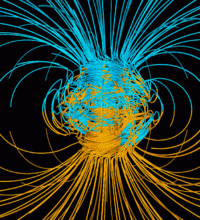
Photo from wikipedia
We provide a statistical analysis of both electric and magnetic field wave amplitudes of very low frequency lightning‐generated waves (LGWs) based on the equivalent of 11.5 years of observations made… Click to show full abstract
We provide a statistical analysis of both electric and magnetic field wave amplitudes of very low frequency lightning‐generated waves (LGWs) based on the equivalent of 11.5 years of observations made by the Van Allen Probes encompassing ~24.6 × 106 survey mode measurements. We complement this analysis with data from the ground‐based World Wide Lightning Location Network to explore differences between satellite and ground‐based measurements. LGW mean amplitudes are found to be low compared with other whistler mode waves (1 ± 1.6 pT and 19 ± 59 μV/m). Extreme events (1/5,000) can reach 100 pT and contributes strongly to the mean power below L = 2. We find excellent correlations between World Wide Lightning Location Network‐based power and wave amplitudes in space at various longitudes. We reveal strong dayside ionospheric damping of the LGW electric field. LGW amplitudes drop for L < 2, contrary to the Earth's intense equatorial lightning activity. We conclude that it is difficult for equatorial LGW to propagate and remain at L < 2.
Journal Title: Geophysical Research Letters
Year Published: 2020
Link to full text (if available)
Share on Social Media: Sign Up to like & get
recommendations!